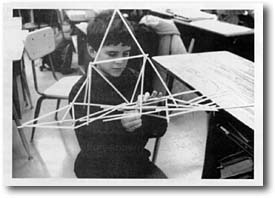![]()

![]()
Building out with straws and pins provides students the opportunity to
experience many of the basic physics and engineering concepts inherent
in structures. Building out means that most of the structure's weight
is out and away from the point of support. Bridges (with support at two
ends) and cantilevers (with support at only one end) are two straightforward
examples of these types of structures. Building out emphasizes experience
with the concepts of torque (the combination of force and distance from
a pivot point) and center-of-mass (the balance point).
This activity provides a good opportunity to ask students to talk about
bridges and cantilevers that they know. There are many bridges around
to talk about. They range from monuments like the Golden Gate or Brooklyn
bridges to simple logs thrown across a creek. Examples of cantilevers
include balconies, awnings hanging in front of buildings, branches on
trees, or even our arms when we hold them out. Discussion of examples
like these invite your students to bring their own experience into the
understanding of building out.
![]()
If these are new materials,
it is important to give your students time to freely explore with the
straws and pins. Ask your students, "What can you build with 50 straws
and 50 pins?" and let the students explore their ideas. Some teachers
prefer to use straws and paper clips to avoid problems of getting stuck
by pins, especially with younger students. However, building out (particularly
cantilevers) is a good deal more difficult with paper clips. As their
structures begin to take shape, suggest that they use bent paper clips
as hangers for weights to test the physical strength of the structures.

